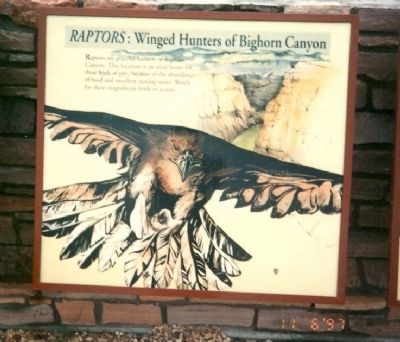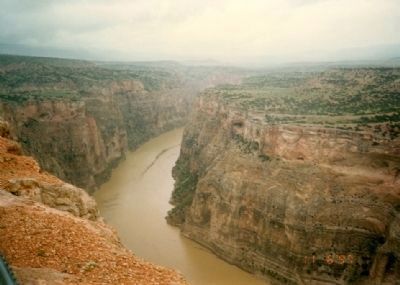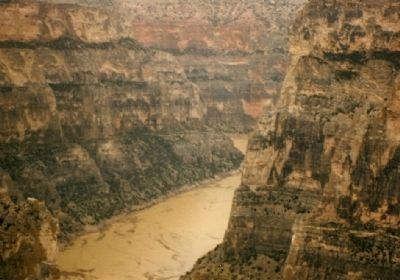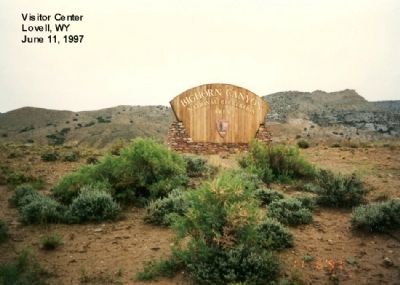Lovell in Big Horn County, Wyoming — The American West (Mountains)
Raptors: Winged Hunters of Bighorn Canyon
Bighorn Canyon National Recreation Area
— National Park Service, U.S. Department of the Interior —
Erected by National Park Service.
Topics. This historical marker is listed in this topic list: Animals.
Location. 44° 51.282′ N, 108° 11.946′ W. Marker is in Lovell, Wyoming, in Big Horn County. Marker is on U.S. 14. Touch for map. Marker is in this post office area: Lovell WY 82431, United States of America. Touch for directions.
Other nearby markers. At least 3 other markers are within 10 miles of this marker, measured as the crow flies. Mason-Lovell Ranch (approx. 2.6 miles away); Henry Gilbert, Jr. Memorial (approx. 9½ miles away); The Jeep (approx. 9½ miles away).
Regarding Raptors: Winged Hunters of Bighorn Canyon. Grandest Canyon in the Northern Rockies
A landscape of sheer cliffs towering 1,000 feet above a ribbon of blue water. World class fishing and a place where wild horses still run free. Bighorn Canyon is a place where imagination meets reality. Bighorn Canyon has unrivaled recreation possibilities.
History & Culture
If you love history, then Bighorn Canyon is the place to be!
From paths blazed by Paleo-Indians, to the story of the Crow people’s fight for land and justice. From the era of mountain men and their transforming passages through the area, to the story of the first war lost by the United States government.
The historical legacies of open range, family and dude ranching and a host of eccentrics living out extraordinary lives live on at the park. Fast forward to our own times, where the harnessing of a river’s power helps set light to our world and today, where two hundred thousand arrive annually in search of their own adventure.
The history of the Bighorn Canyon area illustrates how humans left their imprint upon the landscape and how the land itself shaped their lives into a story unsurpassed in the history of the American West.
Nature & Science
Bighorn Canyon is a geologist’s dream and an animal lover’s paradise. Bighorn Canyon offers a diverse landscape of forest, mountains, upland prairie, deep canyons, broad valleys, lake and wetlands. The wildlife is equally diverse. From the fabulous Pryor Mountain Wild Horses to the majestic Bighorn Sheep, hundreds of bird species and a world class fishery, Bighorn Canyon is truly one of the most significant natural areas in the United States.
The National Recreation Area
Bighorn Canyon National Recreation Area (NRA) manages approximately 68,000 acres between the Pryor and Bighorn mountain ranges on the Montana-Wyoming boundary. The park was established in 1966 to preserve the area’s natural and cultural resources and provide for public enjoyment after Yellowtail Dam was constructed by the Bureau of Reclamation (BOR) on the Bighorn River. The resulting Bighorn Lake extends for approximately 71 miles (114 km) at full pool.
Massive and Ancient
The depth of Bighorn Canyon is approximately 1,000 feet deep at Devil Canyon and 2,500 feet deep on Bull Elk Ridge. Researchers have found Upper Jurassic Period fossils and fossil tracks and bones in the park, and discovered the remains of Pleistocene animals in debris piles at cave entrances.
Animals
Wildlife in Bighorn Canyon NRA includes bighorn sheep, wild horses, coyotes, mule deer, snakes, small mammals, mountain lions, bears, and more than 200 bird species. The 39,000-acre Pryor Mountain Wild Horse Range, about one-fifth of which lies within Bighorn Canyon NRA, provides habitat for both the sheep and for approximately 160 wild horses managed by the Bureau of Land Management (BLM).
Vegetation
Vegetation communities in the park include desert shrubland, juniper woodland, mountain mahogany woodland, sagebrush steppe, basin grassland, riparian, and coniferous woodland.
Habitat
The 19,000-acre Yellowtail Wildlife Habitat Management Area, more than half of which lies within Bighorn Canyon NRA, is managed by the Wyoming Game and Fish Department through agreements with the NPS, BLM, and BOR.
Archaeology
Bighorn Canyon’s archeological history includes Bad Pass Trail, which has been used for more than 10,000 years and is marked by 500 rock cairns spread over 13 miles.
Research Today
The primary areas for ongoing research in Bighorn Canyon NRA are paleontology, bighorn sheep, archeology, restoration, revegetation, and seeps and springs water quality. Researchers stay at the Bighorn Canyon Research Center at Ewing-Snell Historic Ranch, a science center with a classroom and camp facilities that has been established at one of four 1890s ranches being restored in the park
National Park Service
Credits. This page was last revised on June 16, 2016. It was originally submitted on December 26, 2012, by Don Morfe of Baltimore, Maryland. This page has been viewed 709 times since then and 16 times this year. Photos: 1, 2, 3, 4. submitted on December 26, 2012, by Don Morfe of Baltimore, Maryland. • Bill Pfingsten was the editor who published this page.



